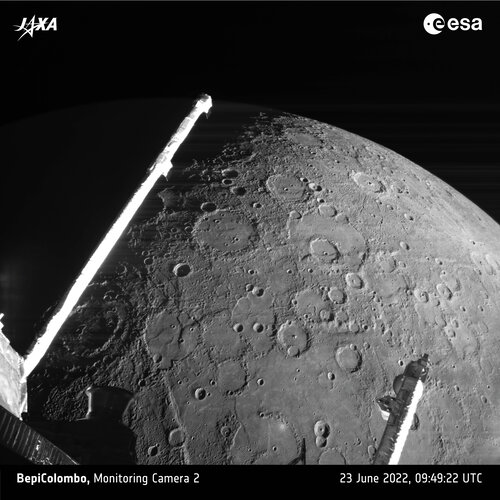The ESA/JAXA BepiColombo mission captured this beautiful view of Mercury’s rich geological landscape on 23 June 2022 as the spacecraft flew past the planet for a gravity assist manoeuvre.
The image was taken at 09:49:22 UTC by the Mercury Transfer Module’s Monitoring Camera 2, when the spacecraft was within about 920 km from the surface of Mercury. Closest approach of about 200 km took place shortly before, at 09:44 UTC. In this view, north is roughly towards the top right.
The cameras provide black-and-white snapshots in 1024 x 1024 pixel resolution. The image has been interpolated to 2048 x 2048 pixels to sharpen the details. Some imaging artefacts such as horizontal striping are also visible.
Parts of the Mercury Planetary Orbiter can also be seen, notably the magnetometer boom running from bottom left to top right, and a small part of the medium-gain antenna at bottom right. The magnetometer boom roughly follows the ‘terminator’– the boundary between the night and day side of the planet. The lighting conditions in this image are different to any recorded by NASA’s MESSENGER mission to Mercury for this region, enhancing the differences between smooth terrains and older rough terrains. Large impact craters, including a 200 km wide multi-ringed basin partly hidden by the magnetometer boom can also clearly be made out along with other geological features.
Click here for an annotated version of this image.
Survey ship
One prominent, straight sunlit scarp runs from the bottom of the image and towards the magnetometer boom. It is about 200 km long – of which 170 km can be seen in this image – and stands 2 km high, and is part of Mercury’s global pattern of geologic faults. Previously unnamed, the International Astronomical Union Working Group for Planetary System Nomenclature assigned it the name ‘Challenger Rupes’ earlier this month, in anticipation of it being well seen in MCAM images during this swingby. This continues the convention of naming Mercury’s escarpments after scientific expeditions and ships used in voyages of discovery; in this case after HMS Challenger, whose 1872-1876 survey of the Atlantic and Pacific oceans and their floors laid the foundations of the modern science of oceanography.
To the right of Challenger Rupes is a 140 km wide unnamed crater which catches the eye thanks to the bright spot at about the one o’clock position just inside the rim, which is relatively fresh ejecta from a small young impact crater. The large crater’s floor is covered by lavas that extend into the surrounding smooth plains (Catuilla Planum). The crater floor is also cut by two prominent fault scarps roughly parallel to Challenger Rupes. The pattern of faults in this region, probably related to a fault system called Beagle Rupes (in darkness and also hidden by the magnetometer boom), surely has a fascinating story to tell about Mercury’s tectonic history – a key aspect of the science BepiColombo will explore once in orbit around the planet and carrying out its main mission from 2026.
Another eye-catching crater is the 130 km-wide Eminescu crater towards the top right of the image, its bright central peak feature catching the sunlight with this viewing angle. This will be a particularly interesting crater for BepiColombo to study as it contains ‘hollows’, geological features unique to Mercury.
The bright streaks radiating from the 24 km-wide Xiao Zhao crater at the right of the image also stand out against the darker background. These ‘rays’ are formed from material ejected during the impact event that carved out the crater, and fade away within a few hundreds of millions of years. This tells us that Xiao Zhao is one of the more recent impact craters on Mercury.
Tantalizing taste
This brief glimpse is a tantalizing taste of the rich geology that BepiColombo is set to study in more detail from orbit. The gravity assist manoeuvre was the second at Mercury and the fifth of nine flybys overall. During its seven-year cruise to the smallest and innermost planet of the Solar System, BepiColombo makes one flyby at Earth, two at Venus and six at Mercury to help steer on course for Mercury orbit in 2025.
The Mercury Transfer Module carries two science orbiters: ESA’s Mercury Planetary Orbiter and JAXA’s Mercury Magnetospheric Orbiter, which from complementary orbits will study all aspects of mysterious Mercury from its core to surface processes, magnetic field and exosphere, to better understand the origin and evolution of a planet close to its parent star.
More images will be released tomorrow, 24 June, with a complete set of flyby images available in the Planetary Science Archive on Monday 27 June. Follow @bepicolombo on Twitter for updates.



 Image:
BepiColombo surveys Mercury’s rich geology
Image:
BepiColombo surveys Mercury’s rich geology